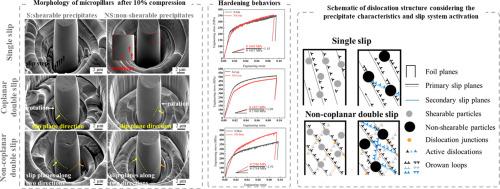Deformation mechanisms of Al alloys containing shearable/non-shearable L12 precipitates: A comparative study under varied slip system activations
IF 9.3
1区 材料科学
Q1 MATERIALS SCIENCE, MULTIDISCIPLINARY
引用次数: 0
Abstract
Although the shearing and bypassing mechanisms have been extensively studied in precipitation-hardened alloys, the effects of shearable and non-shearable precipitates under multiple slip system activation remain not fully understood. This study explores the influence of shearable and non-shearable Al3(Sc, Zr) precipitates on the deformation behavior of Al–Mg–Sc–Zr alloy through micropillar compression tests under three distinct crystallographic orientations: single-slip, coplanar double-slip and non-coplanar double-slip. In single-slip micropillars, shearable precipitates allow dislocations to cut through, resulting in low dislocation storage. In contrast, non-shearable precipitates cause dislocations to bypass via Orowan looping, promoting secondary slip activation and increasing dislocation storage and strain hardening. In coplanar double-slip micropillars, the effect of precipitate type is diminished. Coplanar dislocation reactions forming quadrilateral dislocation structures that suppress secondary slip activation with non-shearable precipitates and increase dislocation storage in those with shearable precipitates, resulting in similar hardening behavior. However, in non-coplanar double-slip micropillars, the effect of precipitate type is drastically pronounced. In micropillars with non-shearable precipitates, complex dislocation interactions (between primary/secondary slip systems and non-coplanar reactive dislocations) lead to cellular dislocation structures and enhanced strain hardening. This work highlights the critical roles of precipitates and slip system activation in governing the underlying deformation mechanisms.


含可剪切/不可剪切L12析出相的铝合金变形机制:不同滑移系统激活下的对比研究
虽然在析出硬化合金中剪切和旁通机制已经得到了广泛的研究,但在多重滑移系统激活下,可剪切和非可剪切析出相的影响仍未完全了解。本研究通过微柱压缩试验,在单滑移、共面双滑移和非共面双滑移三种不同晶型取向下,探讨了可剪切和不可剪切Al3(Sc, Zr)析出物对Al-Mg-Sc-Zr合金变形行为的影响。在单滑移微柱中,可剪切沉淀物允许位错切割,从而导致低位错储存。相反,不可剪切析出物通过Orowan环导致位错绕过,促进二次滑移激活,增加位错储存和应变硬化。在共面双滑移微柱中,沉淀类型的影响减弱。共面位错反应形成四边形位错结构,抑制非剪切析出相的二次滑移激活,增加具有可剪切析出相的位错储存,导致类似的硬化行为。然而,在非共面双滑移微柱中,沉淀类型的影响非常明显。在具有不可剪切沉淀的微柱中,复杂的位错相互作用(在初级/次级滑移系统和非共面反应性位错之间)导致细胞位错结构和增强的应变硬化。这项工作强调了沉淀和滑移系统激活在控制潜在变形机制中的关键作用。
本文章由计算机程序翻译,如有差异,请以英文原文为准。
求助全文
约1分钟内获得全文
求助全文
来源期刊

Acta Materialia
工程技术-材料科学:综合
CiteScore
16.10
自引率
8.50%
发文量
801
审稿时长
53 days
期刊介绍:
Acta Materialia serves as a platform for publishing full-length, original papers and commissioned overviews that contribute to a profound understanding of the correlation between the processing, structure, and properties of inorganic materials. The journal seeks papers with high impact potential or those that significantly propel the field forward. The scope includes the atomic and molecular arrangements, chemical and electronic structures, and microstructure of materials, focusing on their mechanical or functional behavior across all length scales, including nanostructures.
 求助内容:
求助内容: 应助结果提醒方式:
应助结果提醒方式:


